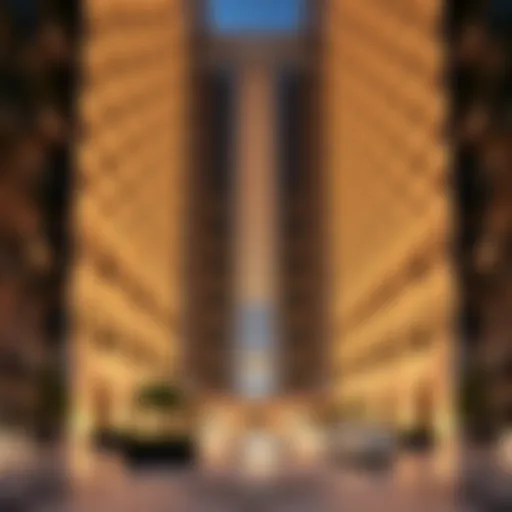Understanding the Financial Landscape of Burj Khalifa
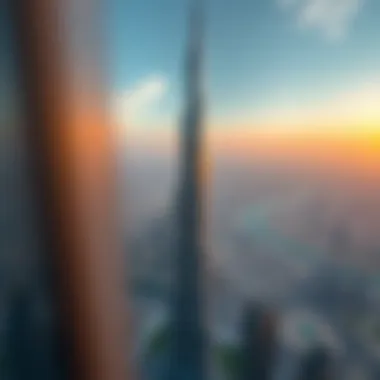
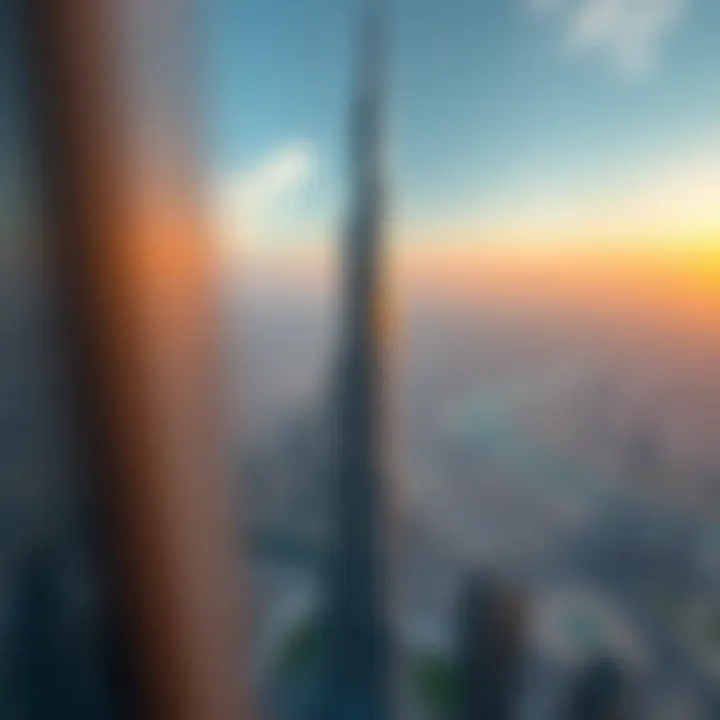
Intro
The Burj Khalifa stands tall, not merely as an architectural spectacle but as a monumental financial entity within the real estate landscape. For prospective investors, real estate agents, and avid followers of market trends, understanding the monetary facets surrounding this iconic skyscraper is crucial. In a city like Dubai, which thrives on innovation and luxury, the price of the Burj Khalifa can offer insights into broader economic conditions and investment possibilities. This piece aims to unravel the various factors that contribute to the Burj Khalifa's price, including market fluctuations, investment opportunities, and comparative evaluations against other prestigious structures.
The discussion will traverse through key themes such as current market conditions and future predictions, leading swiftly into the investment avenues that this unique landmark offers. As we delve deep, it becomes vital to grasp not just the implications of owning property in the Burj Khalifa but also how it positions itself in the ever-evolving global market. Let's get started.
Preamble
The Burj Khalifa stands as a symbol of architectural ambition and modern excellence in the heart of Dubai. Its significance extends beyond being the tallest building in the world; it represents the zenith of luxury and engineering prowess. The importance of this skyscraper goes hand-in-hand with its price, which encapsulates various factors ranging from raw materials to cultural impact. Understanding these elements is crucial not only for real estate professionals, investors, and architecture enthusiasts but also for anyone keen on grasping the financial intricacies surrounding such a monumental structure.
As one delves into the topic of Burj Khalifa, it's important to acknowledge that the building's financial narrative is not simply about numbers. It tells a richer story involving globalization, market demand, and urban development strategies. The costs associated with the Burj Khalifa are influenced by a tapestry of aspects, including the current real estate landscape in Dubai, global economic trends, and the aspirations of affluent individuals seeking luxury. Every brick and windowpane in the structure reflects substantial investments made to push the boundaries of what a building can symbolize.
The benefits of dissecting the price of the Burj Khalifa are manifold. Investors may find insights into potential returns on luxury properties in Dubai, while real estate agents can gain a deeper understanding of the market dynamics that govern high-end real estate. Moreover, for prospective buyers and renters, knowing the value intricacies helps in making informed decisions. Not to forget those curious minds who just want to appreciate how such an architectural marvel affects the skyline and economy of a city—this analysis aims to leave no stone unturned.
In summary, the task at hand is not merely to outline the price of the Burj Khalifa but to explore its significance in the broader context of real estate and economic trends. By breaking down this complex subject, readers will walk away with a more nuanced understanding of the interplay between luxury, market valuation, and architectural significance.
Historical Context
Understanding the Burj Khalifa's price requires delving into its rich historical context. This context sets the stage for appreciating not only the financial intricacies but also the architectural significance of this marvel. The story of the Burj Khalifa is not merely about numbers; it's about vision, ambition, and the drive to create something unparalleled in the world of engineering. Its historical underpinnings play a vital role in assessing its value and relevance in today's real estate market.
Construction Timeline
The construction of the Burj Khalifa commenced in 2004 and reached completion in 2010. Spanning six years, the project saw a rapid evolution from conceptualization to execution. The timeline showcases several key phases:
- 2004: Groundbreaking ceremony took place.
- 2007: The building’s structure surpassed 50 floors, gaining international attention.
- 2009: Major structural work was completed, and the iconic exterior began to take shape.
- 2010: The building was officially opened, marking its place in the world as the tallest skyscraper.
Each phase represented not just construction milestones but also increasing market interest, which played a crucial role in setting its future pricing dynamics.
Original Price and Funding Sources
When first constructed, the Burj Khalifa had an original price tag estimated around $1.5 billion. This astronomical amount was sourced from a mix of public and private funding. The backing came mainly from Emaar Properties, a key player in Dubai's real estate market, which had a vision for transforming the city into a global hub.
- Equity Financing: Emaar utilized investments from private entities, allowing them significant control over the project.
- Bank Loans: Major banks provided loans, indicating confidence in the project’s profitability through increased tourism and fostering a luxury lifestyle.
- Government Support: The Dubai government also played a role, viewing the Burj Khalifa as a symbol of national pride and a catalyst for economic development.
The financial intricacies surrounding the Burj Khalifa reflect a broader narrative of Dubai's ambition to reach for the sky literally and metaphorically. This investment has spurred a range of other developments, securing its standing in the competitive real estate market.
The historical context, thus, illustrates a multifaceted story underlining the Burj Khalifa’s significance within Dubai’s architectural and economic landscape, consequently influencing its market price today.
Current Market Value
The current market value of the Burj Khalifa is a pivotal aspect of understanding its standing in the real estate world. It gives insight into how this architectural gem continues to influence not only Dubai’s skyline but also its economy. As the tallest man-made structure on the globe, the Burj Khalifa captures attention from tourists, investors, and prospective buyers alike. Its value isn't just about the brick and mortar that make up the building; it encapsulates the entire experience, prestige, and demand associated with owning a piece of one of the most recognizable buildings on earth.
Recent Pricing Trends
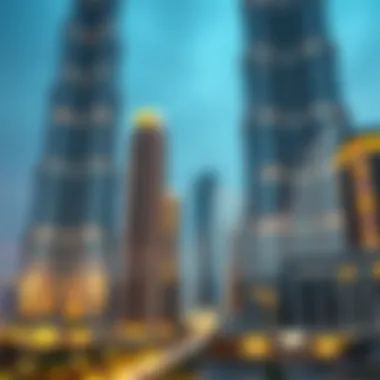
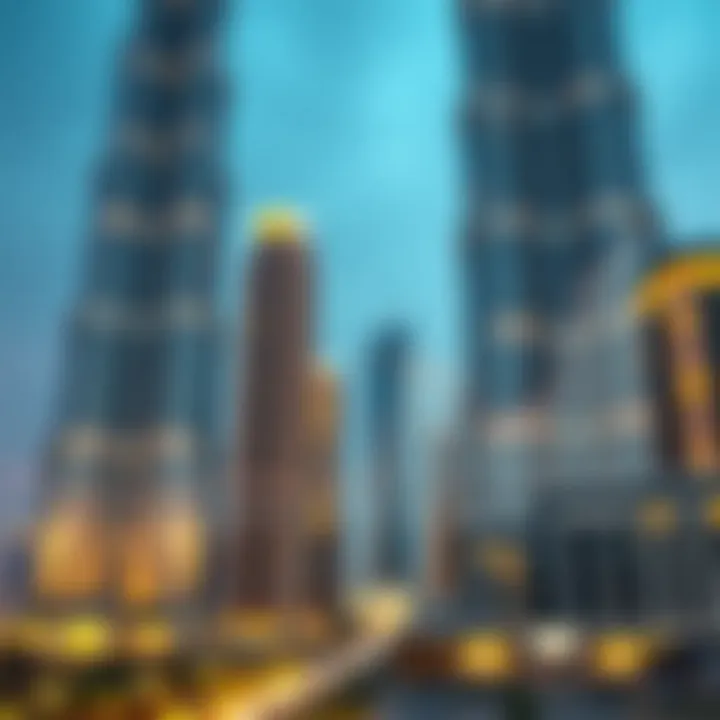
Pricing trends related to the Burj Khalifa reflect broader movements in the luxury real estate sector in Dubai. Notably, recent reports suggest a gradual increase in the market values of residential units within this iconic structure. Several luxury apartments are finding buyers willing to pay a premium for the exclusive address, scenic views, and unique lifestyle that comes with living in such a celebrated landmark. The Burj Khalifa consistently ranks as one of the most sought-after properties, leading many to speculate about its potential for value growth amid fluctuating market conditions.
Factors Affecting Value
Location and Prestige
The location and prestige of the Burj Khalifa play a massive role in its overall value. Situated in the heart of Downtown Dubai, just a stone's throw from the Dubai Mall, its prime position cannot be understated. This area is not merely a hub of shopping and entertainment but a symbol of opulence.
- Visibility: The Burj Khalifa isn’t just another building; it's a landmark that draws millions of tourists each year, bolstering its allure.
- Accessibility: Its proximity to major transportation hubs, including the Dubai Metro and major highways, enhances its desirability.
- Cultural Significance: The building is often featured in international media, serving as a backdrop for numerous events, further amplifying its prestige.
However, living in such a heavily trafficked area has its drawbacks, like noise and congestion that can deter potential buyers.
Luxury Amenities
When discussing luxury amenities, the Burj Khalifa exemplifies what the high end of real estate can offer. Residents enjoy top-notch facilities, from an exclusive lounge and swimming pools to a well-equipped gym.
Some notable amenities include:
- Sky Lounge: An exclusive meeting place on the 148th floor, providing stunning views of the city.
- Spa Facilities: Residents have access to world-class spa services, ensuring a luxurious lifestyle at their fingertips.
This kind of opulence not only enhances the living experience but also justifies the higher price point associated with these properties. However, maintenance costs for such amenities can be substantial, which is something potential buyers need to consider.
Market Demand
Finally, market demand is a crucial factor impacting the price of the Burj Khalifa. The building's iconic status leads to a sustained level of interest from investors and renters alike. High demand often translates into competitive pricing, with many willing to pay top dollar for a chance to call this magnificent structure home.
Several elements illustrate this:
- Short-Term Rentals: The popularity of short-term rentals in Dubai means investors see the potential for significant returns.
- Long-Term Investment: For those looking for long-term value, the Burj Khalifa remains a preferred choice amidst global uncertainties.
Yet, it's important to note that market conditions can fluctuate. An oversaturation of luxury apartments in the market, for instance, could impact pricing negatively.
"The Burj Khalifa remains not only a symbol of architectural achievement but also a cornerstone of Dubai's luxury real estate market, reflecting the dynamics of global investment trends."
Understanding these factors helps buyers and investors make informed decisions, ultimately defining the Burj Khalifa's standing in an ever-evolving market.
Comparative Analysis
Understanding the Burj Khalifa not only requires an examination of its own pricing but also necessitates a look into how it stacks up against other iconic buildings. The comparative analysis is significant as it provides insights into the unique attributes of the Burj Khalifa by placing it alongside familiar structures. This section seeks to underline how the architectural marvel not just holds its ground but establishes benchmarks in terms of pricing, image, and investment potential.
Burj Khalifa vs. Other Iconic Buildings
Eiffel Tower
The Eiffel Tower, a symbol of Paris, holds its price point due to its cultural significance and historical stature. This wrought-iron lattice tower was completed in 1889 and has become a staple of tourist attraction for millions each year. The twinkling lights at night provide a charm that captures both the hearts of tourists and the interest of investors. In terms of comparisons, its limited height and open viewing platform style attract visitors but somewhat limit its potential investment returns when juxtaposed with Burj Khalifa's luxurious amenities. The unique feature of the Eiffel Tower is its ability to rejuvenate itself through seasonal events, which keeps it ever-relevant. However, its age can present challenges in terms of modernization and maintenance, especially when comparing operational expenditures with the high-end options untenable at the Burj Khalifa.


Empire State Building
The Empire State Building, a beacon of New York City, remains a classic representation of urban architecture from the Art Deco era. Built in 1931, it was a monumental project of its time. As an investment, it is popular due to its prime location and continuous commercial endeavors. It's significant that this skyscraper has maintained its iconic status, but it lacks the luxury components that the Burj Khalifa offers, which can drive higher valuations. The Empire State's observation deck provides breathtaking views but not the same level of comfort and luxury found in Burj Khalifa’s lounges and suites. The historical context of Empire State adds to its charm, but it is crucial to recognize that its existing facilities reflect an era that may not entirely appeal to today's luxury-seeking clientele.
Shanghai Tower
The Shanghai Tower stands tall as the second tallest building in the world. Finished in 2015, this architectural wonder is designed with a focus on sustainability and innovation. The tower boasts unique elements like its double skin façade that provides energy efficiency, making it a leading choice for businesses focusing on eco-friendliness. Comparatively, it has a competitive price point when seen alongside the Burj Khalifa. However, its practical appeal lies in corporate leases as opposed to residential luxury, which fundamentally alters its market potential. As a noteworthy addition to the skyline, its sophisticated design can offer insights into future trends in skyscraper construction that Burj Khalifa may adapt as well.
Investment Potential Compared to Peers
In evaluating the investment potential of the Burj Khalifa against its peers, it is clear that its luxury market positioning, prime location, and architectural innovation provide a distinct advantage. From residential units that offer a blend of exclusivity and comfort to various entertainment and leisure facilities, this building raises the bar not just for lifestyle but also for return on investment. Whereas the iconic structures like the Eiffel Tower or Empire State may have reached a plateau in investor interest, Burj Khalifa continues to thrive as a hotspot for significant financial prospects.
A thorough analysis reveals that while each of these landmarks has its unique appeal and market, the Burj Khalifa’s combination of luxury, location, and global recognition reinforces its status not just as an architectural feat, but as a smart investment opportunity for discerning buyers and investors.
Real Estate Landscape in Dubai
Dubai’s real estate market is an intricate tapestry woven from diverse elements, each adding its unique thread to the fabric of the city’s skyline. The Burj Khalifa, standing as the towering epitome of luxury and ambition, serves as a crucial landmark in this landscape. Understanding the broader picture of Dubai's real estate is imperative for anyone interested in the financial implications of investing in properties such as the Burj Khalifa.
Dubai’s real estate is not just about buying and selling buildings; it's about understanding the socio-economic factors at play. From the influx of international investors to the increasing local demand driven by a growing population, there are countless elements that shape the market. Notably, the city operates within a framework that combines modern efficiency with rich traditions, making it a hotspot for investment.
Current Market Conditions
The current market conditions in Dubai paint a picture of resilience in the face of global economic shifts. The city has witnessed a significant rebound in property prices following the pandemic-related downturns. According to numerous reports, prices are on the rise again, fueled by a resurgence in tourism and business activities. The government's initiatives aimed at diversifying the economy beyond oil dependency, such as the creation of freehold zones, have also contributed positively to the real estate sector.
Key Factors Influencing Current Market Conditions:
- Regulatory Changes: New laws favoring foreign ownership and long-term residency for investors have made Dubai more attractive.
- Tourism Recovery: As travel restrictions ease, the influx of tourists has bolstered demand for both short-term rentals and luxury residential units.
- Smart City Initiatives: Investments in technology and infrastructure are making Dubai more accessible and appealing to investors.
Overall, the market currently shows promising signs, reflecting both the global economic trends and specific dynamics at play in the region.
Role of Luxury Properties
Luxury properties in Dubai do more than provide opulent living conditions; they represent a crucial segment of the real estate landscape, significantly influencing overall market performance. The luxury segment, particularly properties like the Burj Khalifa, not only attracts affluent buyers but also serves as a benchmark for the pricing landscape across the board.
Investors are drawn to the luxury market not just for personal use but also as a lucrative investment avenue. These high-value properties often generate substantial rental yields and have shown strong value appreciation over time. Consider the following points:
- Attracting Global Investors: Luxury properties draw not just local buyers but also international magnates and corporations. The high concentration of wealth concentrates demand.
- Reputation and Status: Owning property in a prestigious location like the Burj Khalifa enhances social standing, creating a psychological appeal that goes beyond mere monetary value.
- High-End Amenities: These properties often come equipped with state-of-the-art facilities and exclusive services that further enhance their attractiveness.
In summary, the luxury property market in Dubai is not just a niche; it is a pivotal player that shapes investor perceptions, market dynamics, and overall economic health. With this understanding, potential buyers and investors can navigate this complex landscape with a more informed perspective.
Economic Impact of Burj Khalifa
The Burj Khalifa is not just a grand architectural feat; it's also a cornerstone of Dubai's economy. This towering skyscraper influences various sectors significantly, from tourism to real estate. Understanding the economic impact of the Burj Khalifa is vital in recognizing how it contributes to the local, regional, and even global economy.
With its iconic status, the Burj Khalifa attracts millions. The building serves as a nexus where economic activities intermingle with lifestyle aspirations. It is, therefore, essential to evaluate its impact not just from an operational perspective but also in terms of long-term economic strategies for Dubai.


Tourism and Revenue Generation
Tourism forms the backbone of Dubai's economy, and the Burj Khalifa plays a pivotal role in this. Every year, millions flock to see the tallest building in the world, with many also eager to experience its observation decks and luxury dining establishments. But what does this mean for the local economy?
- Visitor Expenditure: Tourists spend on average about $100 when visiting the Burj Khalifa. This can be broken down into ticket sales, dining, and shopping. Given that the building attracts around 1.9 million visitors each year, the financial waterfall from just ticket sales alone can be quite substantial.
- Employment Opportunities: The presence of the Burj Khalifa creates a ripple effect in employment. From hospitality jobs in nearby hotels to retail positions in adjacent malls, thousands of jobs are directly and indirectly linked to the tourism generated by the building.
- Event Hosting: The Burj Khalifa often hosts international events, effectively making Dubai a global destination for conferences and exhibitions. This not only generates immediate revenue but also promotes long-term business prospects for the city.
Effects on Local Real Estate Values
The Burj Khalifa's influence extends beyond tourism, permeating the real estate market as well. The presence of such an iconic structure positively impacts the property values in its vicinity.
- Increased Property Demand: Properties located near the Burj Khalifa command higher prices due to their prestigious location. Buyers are often willing to pay a premium for a view of the skyscraper, elevating property values significantly.
- Luxury Development Initiatives: The surge in interest around the Burj Khalifa has led to the development of luxury properties like the Dubai Mall and ultra-modern condominiums. These projects not only uplift the area but also cater to affluent buyers seeking high-end living experiences.
- Long-term Investment: The Burj Khalifa has become synonymous with luxury and modernity; as a result, real estate investors often view properties near the tower as long-term investment opportunities. The sustained influx of high-income residents can lead to substantial appreciation in property values over time.
Overall, the Burj Khalifa has created an ecosystem where real estate values thrive due to its sheer presence, making it an invaluable asset not only for Dubai but also as a case study in urban development.
Future Projections
The future projections of the Burj Khalifa's price and market dynamics offer a crucial window into the potential longevity and relevance of this architectural giant within the competitive real estate landscape. Understanding these projections is pivotal for investors, developers, and real estate enthusiasts alike, as they reveal not just the anticipated value but also broader market trends influenced by the unique characteristics of the Dubai property market. As more investors keep their eyes peeled on this iconic structure, factors like economic shifts, tourism trends, and technological breakthroughs carry immense weight in shaping these projections.
Predicted Price Trajectories
Forecasting the price trajectory of the Burj Khalifa is akin to reading the tea leaves; it requires a careful analysis of past performance alongside current market indicators. Several considerations need to be factored into this analysis:
- Economic Growth Rates: With Dubai experiencing dynamic economic shifts, especially post-pandemic, the growth rates of key sectors such as tourism and hospitality significantly impact property values. If economic stability continues, one could see a positive escalation in prices.
- Supply and Demand Dynamics: The real estate market in Dubai is often influenced by international demand. Assets like the Burj Khalifa, which command attention on a global scale, may experience higher demand that could push prices upward, even amidst market fluctuations.
- Inflation Effects: While inflation generally eats away at purchasing power, in high-standard luxury real estate, the price adjustments may not reflect the usual downturns. Instead, premium properties can achieve and maintain higher valuations.
An analysis conducted in 2022 suggested that if the prevailing conditions maintain, the value of Burj Khalifa could potentially increase by 5-7% annually over the next decade. Though unpredictable, the property's market appeal remains solid.
Market Adaptations and Innovations
Adapting to market shifts and technological advancements is essential to the future viability of the Burj Khalifa and similar luxury properties. Here’s how market adaptations and innovations shape the Burj Khalifa's position in the property market:
- Sustainability Initiatives: The growing trend toward sustainability in construction and property management could enhance the Burj Khalifa’s appeal. Innovations in energy efficiency or eco-friendly infrastructure can redefine luxury and make this great building more desirable to environmentally conscious investors.
- Smart Building Technologies: The integration of smart technologies into buildings is no longer just a perk—it's becoming a requirement. Advanced systems to monitor energy use or enhance security may not only bolster the efficiency of the Burj Khalifa but also attract buyers interested in cutting-edge amenities.
- Adaptive Revenue Models: Diversifying income streams will be essential. This includes exploring additional revenue methods through immersive experiences or cultural events held in and around the building, thereby enriching tourism and enhancing its market piggyback.
Overall, the Burj Khalifa stands at a pivotal junction where its future is not merely dependent on its past but entails how well it adapts to evolving market trends. Investments—not just in property but in innovation—are essential for sustaining its iconic status and elevating its value in the long run.
The Burj Khalifa is more than just a building; it’s a testament to the ever-evolving transformation of Dubai’s real estate landscape.
Ending
In wrapping up our exploration of the Burj Khalifa's price dynamics, we must shine a light on the multifaceted elements that govern its valuation. The conclusion section succinctly consolidates the insights gathered throughout the article while underscoring some vital considerations for potential investors and stakeholders in the luxury real estate market. The narrative weaves together the historical context, current economic indicators, and futuristic projections of the Burj Khalifa's financial standing, bringing clarity to what is already a complex topic.
Summary of Findings
The findings suggest that the Burj Khalifa stands as more than just an architectural marvel; it serves as a beacon within the real estate sector of Dubai. Here are key points drawn from our analysis:
- Historical Significance: Its construction marked a pivotal moment in Dubai's growth story, symbolizing the city's ambition and economic potential.
- Current Market Trends: Recent performance indicates a fluctuating yet upward trend in value, driven by ongoing demand for high-end properties and tourism.
- Investment Viability: Our comparative analysis revealed that, when stacked against rivals like the Eiffel Tower and the Empire State Building, Burj Khalifa holds a competitive edge in terms of investment appeal and luxury experience.
Final Thoughts on Investment Potential
As we peer into the horizon, it becomes evident that the Burj Khalifa is poised for sustained relevance in the luxury real estate space. For investors considering this iconic structure, a few elements merit attention.
- Location: Nestled in Downtown Dubai, it not only boasts unparalleled views but also proximity to commercial hubs, enhancing its value.
- Luxury Amenities: The building houses some of the world’s most extravagant facilities, appealing to a discerning clientele.
- Market Adaptability: The evolving demands of the real estate market hint at innovative adaptations in offerings, ensuring that Burj Khalifa remains attractive in a competitive landscape.

